Everything about Welding: Key Insights Into Techniques and Ideal Practices for Success
Welding includes a range of methods, each matched for certain materials and applications. Understanding these approaches, such as GMAW, SMAW, and TIG, is important for attaining optimal outcomes. In addition, the ideal devices and safety methods can not be overlooked. As preparation and fixing play crucial duties in the welding procedure, mastering these elements can significantly improve the quality of the last item. What are the essential aspects that guarantee a successful weld?
Recognizing Various Welding Techniques
Welding strategies incorporate a variety of methods, each matched to specific applications and materials. Amongst one of the most usual techniques are Gas Metal Arc Welding (GMAW), Secured Steel Arc Welding (SMAW), and Tungsten Inert Gas Welding (TIG) GMAW, likewise called MIG welding, is popular for its rate and adaptability, making it optimal for slim products. SMAW, or stick welding, is favored for its simpleness and effectiveness in exterior atmospheres, especially with thicker metals. TIG welding offers accuracy and control, making it ideal for intricate job and non-ferrous steels (Welding). Each method has its distinct advantages and factors to consider, allowing welders to select the most effective technique based upon the job's demands, product kind, and desired results. Comprehending these techniques is vital for effective welding
Crucial Welding Tools and Devices
While different welding methods call for certain skills, the right devices and tools are just as crucial for accomplishing top quality outcomes. Important welding devices includes welding equipments, which vary depending on the method-- such as MIG, TIG, or stick welding. Protective gear, including helmets, handwear covers, and aprons, guarantees safety and convenience during the process. In enhancement, clamps and components assist safeguard products in location, guaranteeing accuracy in welds. Consumables like welding rods, cable, and protecting gas are additionally crucial components that affect the quality of the weld. Additionally, devices such as cutters and mills help with surface area preparation and post-weld completing, adding to a specialist end result. Purchasing top quality devices eventually improves the effectiveness and efficiency of welding jobs.
Safety And Security Practices in Welding
Correct safety and security techniques are vital in the welding industry to shield workers from potential hazards. Welders should wear appropriate individual safety equipment (PPE), consisting of headgears with appropriate shading, gloves, and flame-resistant clothing. Appropriate ventilation is important to reduce direct exposure to dangerous fumes and gases created during the welding procedure. Furthermore, employees should be educated in the right handling of welding devices to avoid mishaps. Fire safety steps, such as keeping combustible products far from the welding area and having fire extinguishers readily offered, are needed. Routine evaluations of devices and workspaces can assist determine possible risks prior to they lead to crashes. By adhering to these safety and security methods, welders can create a more secure working setting and lessen dangers connected with their profession.
Readying Products for Welding
Preparing products for welding is an important step that greatly influences the top quality and integrity of the final product (Welding). Proper prep work entails cleaning up the surfaces to eliminate impurities such as corrosion, oil, and dust, which can jeopardize the weld. Techniques such as grinding, fining sand, or utilizing solvents are frequently employed to attain a tidy surface. Additionally, making sure that the products mesh snugly is important; gaps can cause weak welds. It's also vital to take into consideration the placement and positioning of the elements, as this will affect the ease of welding and the final end result. Selecting the ideal filler product and making certain compatibility with the base metals is vital for attaining strong, long lasting welds.
Tips for Getting High-Quality Welds
Attaining high-grade welds needs focus to detail and adherence to ideal methods throughout the welding process. Correct joint prep work is vital, guaranteeing surface areas are clean and free from impurities. Choosing the suitable filler material and welding strategy based upon the base steels is essential for ideal bonding. Preserving constant travel rate and angle while welding can stop issues and promote uniformity. Additionally, controlling heat input is necessary; excessive warm can cause bending and weakened joints. If needed, frequently checking the welds throughout the procedure allows for instant changes. Employing suitable post-weld treatments, such as cleaning and stress relief, can boost the resilience and honesty of the weld, eventually ensuring a successful outcome.
Fixing Typical Welding Issues
Welding usually offers difficulties that can affect the high quality and stability of the final item. Typical issues such as porosity, irregular weld beads, and getting too hot can develop, each requiring specific troubleshooting strategies. Understanding these troubles is crucial view it for welders to boost their abilities and attain excellent outcomes.
Porosity Troubles Described
Porosity can usually be forgotten, it continues to be a critical problem in welding that can endanger the integrity of a completed item. Porosity refers to the presence of small gas pockets within the weld bead, which can lead and compromise the joint to early failure. This trouble normally emerges from pollutants, wetness, or inappropriate shielding gas protection throughout the welding procedure. To alleviate porosity, welders must validate that the base products are dry and clean, make use of suitable securing gases, and maintain constant welding parameters. On a regular basis evaluating the equipment and atmosphere can additionally help determine prospective problems prior to they materialize in the weld. Attending to porosity efficiently is vital for attaining strong, sturdy welds that fulfill high quality requirements.

Inconsistent Weld Beads
Irregular weld beads can significantly impact the quality and toughness of a completed item. Various elements add to this concern, consisting of improper travel speed, inaccurate amperage settings, and inconsistent electrode angles. When the welder relocates too rapidly, a bead may show up narrow and lack infiltration, while moving too slowly can create extreme buildup. Furthermore, utilizing the incorrect amperage can result in either damaging or extreme spatter, both of which concession weld integrity. The welder's click here now technique, such as inconsistent lantern activity, can also result in unequal bead look. To minimize these problems, welders need to focus on preserving consistent, controlled activities and making sure appropriate devices settings to accomplish uniformity in their welds. Uniformity is crucial to accomplishing solid and reputable welds.
Overheating and Warping Issues
Extreme warm throughout the welding procedure can result in considerable overheating and contorting problems, impacting the architectural stability of the workpiece. These issues often show up as distortion, which can compromise alignment and fit-up, making more assembly challenging. Factors contributing to overheating include the choice of welding parameters, such as voltage and take a trip speed, in addition to the type of product being welded. To mitigate these issues, welders need to keep regular traveling rate and ideal warm input while keeping an eye on the workpiece temperature. Furthermore, preheating or post-weld warm therapy can help minimize anxieties brought on by quick air conditioning - Montana Mobile Welding and Repair Belgrade Fabrication. Normal assessment and adherence to best techniques are important in stopping overheating and ensuring the longevity and dependability of welded frameworks
Frequently Asked Questions
What Are the Profession Opportunities in the Welding Sector?
The welding market supplies varied occupation possibilities, consisting of placements as welders, instructors, inspectors, and designers. Experts can work in production, building and construction, aerospace, and vehicle markets, gaining from strong demand and affordable incomes in different duties.
Exactly How Can I Boost My Welding Speed Without Giving Up High Quality?
To improve welding speed without giving up high quality, one should exercise effective strategies, keep equipment, optimize settings, and boost hand-eye sychronisation. Routine training and looking for feedback can likewise substantially add to achieving faster, high-grade welds.
What Certifications Are Available for Welders?
Various certifications exist for welders, including those from the American Welding Culture (AWS), the National Center for Building And Construction Education And Learning and Research (NCCER), and various industry-specific companies. These qualifications enhance employability and show ability efficiency.
Just How Does Welding Influence the Residences of Metals?
Welding influences the residential properties of metals by changing their microstructure, which can lead to modifications in firmness, ductility, and stamina. Warm input and air conditioning rates throughout the procedure considerably impact these material characteristics.
Can I Weld Dissimilar Metals With Each Other?
